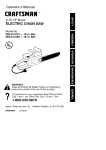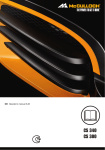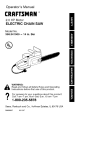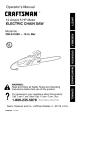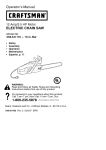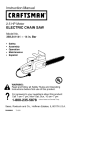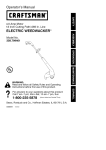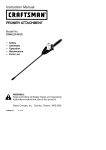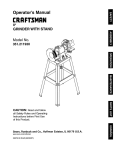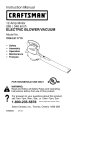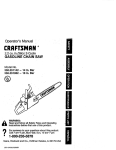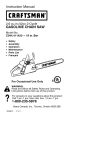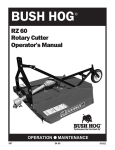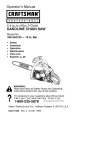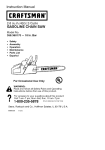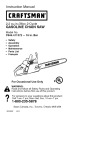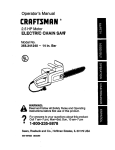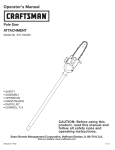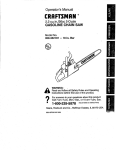Download Craftsman 358.341020 Operator`s manual
Transcript
Operator's Manual CRAFTSMAN 3.0 HP Motor ELECTRIC CHAIN Model No. 358.341020 SAW - 16 in. Bar ® & WARNING: Read and follow all Safety Rules and Operating Instructions before first use of this product. For answers Call 7 am-7 to your questions about this product: pm, Mon-Sat; Sun, 10 am-7 pm 1-800-235-5878 Sears, Roebuck 530084932 and Co., Hoffman 12/29/99 Estates, IL 60179 USA Warranty Safety Rules Assembly Operation Maintenance Service and Adjustments 2 2 7 8 13 14 Customer Serviceable Storage Trouble Shooting Spanish Parts Ordering Parts 15 16 16 19 Back FULL ONE YEAR WARRANTY ON CRAFTSMAN ELECTRIC CHAINSAW. If this Craftsman Electric Chain Saw fails to perform properly due to a defect in material or workmanship within (1) year from the date of purchase, Sears will repair or replace it, free of charge. This warranty excludes the bar and chain, which are expendable parts and become worn during normal use. If this Craftsman Electric Chain Saw is used for commercial purposes, this warranty applies for only 90 days from the date of purchase. If this Craftsman Electric Chain Saw is used for rental purposes, this warranty applies for only 30 days from the date of purchase. This warranty applies only while this product is in use in the United States. WARRANTY SERVICE IS AVAILABLE BY RETURNING THE CRAFTSMAN ELECTRIC CHAIN SAW TO THE NEAREST SEARS SERVICE CENTER IN THE UNITED STATES. This warranty gives you specific legal rights, and you may also have other rights which vary from state to state. Sears, Roebuck and Co., D/817 WA, Hoffman Estates, IL 60179 WARNING: When using an electric chain saw, basic safety precautions should always be followed to reduce the risk of fire, electric shock, and injury to persons, including the following. Read all instructions. WARNING: Always disconnect power source when making repairs. Because a chain saw is a high-speed woodcutring tool, careless or improper use of this tool can cause serious injury. PLAN AHEAD • Restrict the use of your saw to adult users who understand and can follow the safety rules, precautions, and operating instructions found in this manual. • Keep children away. Do not let visitors contact chain saw or extension cord. All visitors should be kept at least 30 feet (10 meters) away from work area. • Dress properly. Wear protective gear. Always use steel-toed safety footwear with non-slip soles; snug-fitting clothing; heavy-duty, non-slip gloves; eye protection such as non-fogging, vented goggles or face screen; an approved safety hard hat; and sound barriers (ear plugs or mufflers) to protect your hearing. Regular users should have hearing checked regularly as chain saw noise can damage hearing. Secure hair above shoulder length. Do not wear loose clothing or jewelry. They can get caught in moving parts. Hearing _ Safety Hat Protection'''_ Ig'g_ Eye Protection Snug Fitting Heavy Duty Clothing _/ Gloves Safety Shoes Safety Chaps Keep all parts of your body away from the chain when the saw is running. Do not handle or operate a chain saw when you are fatigued, ill, or upset, or if you have taken alcohol, drugs, or medication. You must be in good physical condition and mentally alert. If you have any condition that might beaggravated bystrenuous work, • Make certain sawchain stopsmoving check withdoctor before operating. when thetrigger switch isreleased. Watch what youaredoing.Usecom-• Keep thehandles dryandcleanand monsense. freefromoilandgrease. • Donotstartcutting untilyouhavea • Keep oilcapandfasteners securely clear workarea, secure footing, and tightened. especially ifyouarefelling atree,a • UseonlyCraftsman accessories and retreat path.Keep workareaclean. replacement partsasrecommended. Cluttered areas invite injuries. Never modify yoursaw. chain sawwithcare. OPERATE YOURSAWSAFELY • Maintain toolssharp andclean forbetter • Donotoperate withonehand. Seri- • Keep saferperformance. ousinjury totheoperator, helpers, or • and Follow instructions forlubricating and bystanders mayresult fromoneaccessories. handed operation. Achainsawisin- • changing Disconnect chain sawwhennotin tended fortwo-handed use. before servicing andwhen • Donotoperate sawfromaladder or use, accessories andattachinatreeunless youarespecifically changing ments, suchassawchain andguard. trained todoso. damaged parts.Before further • Make surethechain willnotmake • Check ofthechain saw, aguard orother contact withanyobject whilestarting use partthatisdamaged should becarefulthesaw.Never trytostartthesaw lychecked todetermine thatitwilloperwhen theguide barisinacut. properly andperform itsintended • Donotputpressure onthesaw, espe- ate Check foralignment ofmovcially attheendofthecut.Doing socan function. ingparts, binding ofmoving parts, cause youtolosecontrol when cutis ofparts, mounting andany completed. Allow chain tocutforyou. breakage conditions thatmayaffect itsopExert onlylight downward pressure. other Aguard orother partthatis • Stopthesawbefore setting itdown. eration. damaged should beproperly repaired • Hand carrysawonlywhen motor is byanauthorized service stopped. Carry thechain sawbythe orreplaced unless otherwise indicated elsefront handle withthesawstopped, fin- center where intheinstruction manual. gerofftheswitch, theguide barand • Donotoperate achain sawthatis sawchain totherear. improperly adjusted, orisnot • Keep allparts ofthebody away from damaged, completely andsecurely assembled. sawchain when themotor isoperating. notinuse,chain saws should be • Don't forcechainsaw. Itwilldothejob • When inadry, andhighorlocked-up better andsafer attherateforwhich it stored wasintended. place - outofthereach ofchildren. • Store idlechain saw. • Usetherighttool,cutwoodonly. storing saw,unplug andusea Don'tusechain sawforpurpose not • When scabbard orcarrying case. intended - forexample - don'tuse ELECTRICAL £AFETY chain sawforcutting plastic, masonry, non-wood building materials. • Useavoltage supply asshown onunit. • Useextreme caution when cutting • Avoid dangerous environments. Don't smallsizebrush andsaplings beuse appliances indamp o rwet l ocacause thetender material maycatch tions. Don'tuseinrain. thesawchain andbewhipped toward• Avoid dangerous situations. Donotuse youorpullyouoffbalance. presence offlammable liquids or • When cutting alimbthatisunder ten- inthe gases toavoid creating afireorexplosionbealertforspring back sothat sionand/or causing damage tounit. youwillnotbestruck when thetentheriskofelectrical shock, sioninthewood fibers isreleased. • Toreduce appliance hasapolarized plug MAINTAIN YOURSAWINGOOD this (one blade iswider thantheother) and WORKING ORDER require theuseofa polarized ex• Have allchainsawservice performedwill cord. Theappliance plugwillfit byaqualified service dealer except tension apolarized extension cord only theitems listed inthemaintenance into oneway. Iftheplugdoes notfitfully section ofthismanual. intotheextension cord, reverse the plug. Iftheplugstilldoes notfit,obtain acorrect polarized extension cord. A polarized extension cord willrequire the Kickback Path useofa polarized walloutlet. Thisplug willfitintothepolarized walloutlet only oneway. Ifplugdoes notfitfullyinto thewalloutlet, reverse theplug. Ifthe plugstilldoes notfit,contact aqualified electrician toinstall theproper walloutlet.Donotchange theequipment plug, Avoid Obstructions extension cordreceptacle, orextension cordpluginanyway. • Toreduce riskofelectrical shock, use extension cords specifically marked assuitable foroutdoor appliances having electrical rating notlessthan Clear The Working Area therating ofunit.Cord mustbe WARNING: Rotational Kickback can marked withsuffix "W-A"(inCanada when the moving chain contacts "W"). Make sureyourextension cord occur isingoodcondition. Inspect exten- an object at the upper portion of the tip bar. Contact at the upper sioncordbefore useandreplace if of the guide of the tip of the guide bar can damaged. Anundersized extension portion the chain to dig into the object, cordwillcause adropinlinevoltage cause stops the chain for an instant. resulting inlossofpower andover- which The result is a lightning fast, reverse heating. Ifindoubt, usethenext which kicks the guide bar up heavier gauge. Thelower thegauge reaction and back toward the operator. number, theheavier thecord.(See "Selecting anextension cord") Pinch-Kickback and Pull-In occur when • Donotabuse cord.Never carrythe the chain is suddenly stopped by being unitbytheextension cordoryankex- pinched, caught, or by contacting a fortension cordtodisconnect unit. eign object in the wood. This sudden • Secure extension cordtopowercordstopping of the chain results in a revertoprevent disconnection fromunit. sal of the chain force used to cut wood • Donotusetheunitiftheswitch does and causes the saw to move in the opnotturntheunitonandoffproperly, or posite direction of the chain rotation. ifthelockout doesnotwork.RepairsPinch-Kickback drives the saw straight totheswitch must bemade byyour back toward the operator. Pull-In pulls authorized dealer. the saw away from the operator. • Keep theextension cordclear ofopera-KICKBACK WARNING: torandobstacles atalltimes. Position Kickback can occur when the moving cordsothatitwillnotbecaught on contacts an object at the upper branches. Donotexpose cords toheat,chain portion of the tip of the guide bar or oil,water, orsharp edges. the wood closes in and pinches • Toavoid thepossibility ofelectric when saw chain in the cut. The Comshock, avoidbody contact withany the Kickback Angle (CKA) listed on grounded conductor, such asmetal puted your saw and listed in the following fences orpipes. Table represents the angle of kick• Ground Fault Circuit Interrupter CKA your bar and chain combinations (GFCI) protection should beprovidedback will have when tested in accordanced oncircuit oroutlet tobeused.Recep-with CSA and ANSI standards. Comtacles areavailable having built-in puted angles represented in the CKA GFCI protection andmaybeused for column indicate total energy and angle thismeasure ofsafety. Inspect chain associated without a chain brake. sawcords periodically andifdam- When purchasing replacements, conaged, haverepaired byauthorized siderations should be given to the lower service facility. CKA values. In all cases, lower CKA GUARD AGAINST KICKBACK Follow all safety rules to help avoid kickback and other forces which can result in serious injury. values represent a safer operating environment for the user: Do not rely exclusively upon the safety devices built into your saw. • Either ofthese reactions maycause Never Reverse I Keep a firm grip with both hands, youtolosecontrol ofthesawwhich mb under couldresult inserious injury. handle • Pinching thesawchainalong thetip oftheguide barmaypush theguide barrapidly backtowards theoperator.Hand_ • Tipcontact insome cases maycause alightning fastREACTION, kicking theguide barupandback toward the Correct Position Correct Grip Incorrect Grip operator. • A good, firm grip on the saw with both CKATABLE hands will help you maintain control. BAR MODEL 358.341020 P/N 71-36366 CHAIN Length P/N CKA 16" 71-3629 20° REDUCE THE CHANCE OF KICKBACK The following precautions should be followed to minimize kickback: • Grip saw firmly. Hold the chain saw firmly with both hands when the motor is running. Use a firm grip with thumbs and fingers encircling the chain saw handles. • Do not over reach. • Keep proper footing and balance at all times. • Don't let the nose of the guide bar contact a log, branch, ground or other obstruction. • Don't cut above shoulder height. • Use devices such as low kickback chain, guide bar nose guards, chain brakes, and special guide bars that reduce the risks associated with kickback. • Only use replacement bars and chains specified by the manufacturer or the equivalent. Avoid Pinch-Kickback: • Be extremely aware of situations or obstructions that can cause material to pinch the top of or otherwise stop the chain. • Do not cut more than one log at a time. • Do not twist the saw as the bar is withdrawn from an undercut when bucking. Avoid Pull-In: • Always begin cutting with the saw at full speed and the saw housing against wood. • Use wedges made of plastic or wood. Never use metal to hold the cut open. MAINTAIN CONTROL: The following precautions should be followed to minimize kickback. • • • • Don't let go. Grip the rear handle with your right hand whether you are right or left handed. Wrap the fingers of your left hand over and around the front handlebar, and your left thumb under the front handlebar. Keep your left arm straight with the elbow locked. When making bucking cuts, position your left hand on the front handlebar so it is in a straight line with your right hand on the rear handle. Stand slightly to the left side of the saw to keep your body from being in a direct line with the cutting chain. Stand with your weight evenly balanced on both feet. Do not overreach. You could be drawn or thrown off balance and lose control. Do not cut above shoulder height. It is difficult to maintain control of saw above shoulder height. KICKBACK SAFETY FEATURES WARNING: The following features are included on your saw to help reduce hazard of kickback; however, such features will not totally eliminate this danger. Do not rely only on safety devices. • Handguard: designed to reduce the chance of your left hand contacting the chain if your hand slips off the front handlebar. • Position of front and rear handlebars: designed with distance between handles and "in-line" with each other. The spread and "in-line" position of the hands provided by this design work together to give balance and resistance in controlling the pivot of the saw back toward the operator if kickback occurs. • Reduced-Kickback Guide Bar: designed with a small radius tip which reduces the size of the kickback danger zone. This type bar has been demonstrated to significantly reduce the number and seriousness of kickbacks when tested in accordance withANSI B175.1. ._& back performance requirements when tested on the representative sample of these chain saws specified in ANSI B175.1. Low-Kickback Chain Small Radius _J _-_ Large Radius Tip Guide Bar Low Kickback ......... Contoured Depth Gauge Deflects Kickback Force Elongated And Allows Guard Wood Link To Gradually Ride Into Cutter Tip GuideBa,_, Chain has met kick- WARNING /_ / X • \ WARNINGr This chain saw can be dangerousr use can cause serious or even fatal injury. Careless Read and follow all safety precautions in the Operator's Failure to do so can result in serious injury. Always use two hands when operating or improper Manual. the chain saw. Contact of the guide bar tip with any object should be avoided. Tip contact may cause the guide bar to move suddenly upward and backward, which may cause serious injury. I !X _ !,_(_) • Measured maximum kickback value, with and without chain brake, for the bar and chain combination on the label. There may be other replacement components for achieving Kickback protection. Double insulated - When servicing Replace damaged use only identical replacement parts. cord immediately. !5 wet 1Tore donotex roun ttowteoro uoeshoo tee osee _J Hearing protection should be worn. SAFETY NOTICE: Exposure to vibrations through prolonged use of hand tools could cause blood vessel or nerve damage in the fingers, hands, and joints of people prone to circulation disorders or abnormal swelling. Prolonged use in cold weather has been linked to blood vessel damage in otherwise healthy people. If symptoms occur such as numbness, pain, loss of strength, change in skin color or texture, or loss of feeling in the fingers, hands, or joints, discontinue the use of this tool and seek medical attention. An anti-vibration system does not guarantee the avoidance of these problems. Users who operate power tools on a continual and regular basis must closely monitor their physical condition and the condition of this tool. DOUBLE INSULATION CONSTRUCTION This unit is Double Insulated to help protect against electric shock. Double insulation construction consists of two CARTON CONTENTS Models 358,34102 Chain Saw (fully assembled) Extra Chain Bar Sheath Examine parts for damage. Do not use damaged parts. separate "layers" of electrical insulation instead of grounding. Tools built with this insulation system are not intended to be grounded. No grounding means is provided on this unit, nor should a means of grounding be added to this unit. Safety precautions must be observed when operating any electrical tool. The double insulation system only provides added protection against injury resulting from an internal electrical insulation failure. SAVE THESE INSTRUCTIONS STANDARDS: This product is listed by Underwriters Laboratories, Inc. in accordance with UL Standard 1662 and CSA Standards Z62.1 and Z62.3 and ANSI B175.1. THIS CHAIN SAW IS FOR OCCASIONAL USE ONLY NOTE: If you need assistance or find parts missing or damaged, please call 1-800-235-5878 ASSEMBLY Your saw is fully assembled; no assembly is necessary. KNOW YOUR SAW READ THIS OPERATOR'S MANUAL AND SAFETY RULES BEFORE OPERATING YOUR CHAIN SAW. Compare the illustrations with your unit to familiarize yourself with the location of the various controls and adjustments. Save this manual for future reference. Oiler Actuator/ Bar Oil Cap Lockout _ Chain Adjustment _ Screw / Button Trigger Switch Recessed TRIGGER SWITCH The trigger switch is used to turn on the unit. Squeeze the trigger switch to operate the unit after lockout button has been pushed in. Release the trigger to turn the unit off. LOCKOUT BUTTON The Lockout Button is a control feature designed to prevent the motor from being accidently started. When the rear handle is gripped in a normal cutting position, the lockout button can be pushed in by the thumb, permitting the index finger to squeeze the trigger. It is not necessary to maintain pressure on the lockout button once the trigger has been engaged. BAR OIL CAP/OILER ACTUATOR The oil cap is used to access the bar oil tank and pressed to supply oil to chain. CHAIN ADJUSTMENT SCREW The chain adjustment screw is used to adjust the chain tension. RECESSED PLUG The recessed plug is used to connect the chain saw to an approved extension cord. CHAIN TENSION It is normal for a new chain to stretch during first 30 minutes of operation. You should check your chain tension frequently. Readjust chain after every 15 minutes of operation.See Chain Tension under the Service and Adjustments section. Plug OPERATING INSTRUCTIONS Use only a voltage supply as specified on your unit. Extension cords are available for this unit. Secure extension cord to power cord to prevent disconnection from unit. Power Cord SELECT AN EXTENSION CORD MINIMUM WIRE GAUGE RECOMMENDATIONS Volts 100 ft. or less 100 ft. to 150 ft. 14 A.W.G.* 12 A.W.G.* 120 *American Wire Gauge BEFORE STARTING SAW WARNING: Be sure to read the electrical safety information in the safety rules section of this manual before you begin. If you do not understand the electrical safety information do not attempt to use your unit. Seek help from someone that does understand the information or call the customer assistance help line at 1-800-235-5878. GUIDE BAR AND CHAIN OIL The manually operated chain oiler provides lubrication to the chain and guide bar.Besure tofillthebaroiltankbefore • Toavoidlosing control whencutis each cutting session. Theoileractivator/ complete, donotputpressure onsaw baroilcapmust beused regularly and atendofcut. often enough tomaintain athinfilmofoil • Stopmotor before setting sawdown. onthebarandchain while sawiscutting.TREEFELLING TECHNIQUES Itisrecommended thattheoileractuator/ Check forbroken ordead baroilcapbeoperated six(6)times per WARNING: which canfallwhilecutting minute andheldforapproximately three branches serious injury. Donotcutnear (3)seconds each timeitispressed. For causing orelectrical wiresifyoudonot maximum guide barandchain life,we buildings thedirection oftreefall,norcutat recommend useCraftsman chain know saw baroil.Iyou fCraftsman baroilisnot nightsince youwillnotbeabletosee available, youmayuseagood grade well,norduring badweather suchas SAE 30oiluntilyouareabletoobtain rain,snow, orstrong winds, etc.Ifthe Craftsman brand. Theoiloutput ismanu- does make contact withanyutility allymetered during operation. Useafun-tree line, theutility c omplany benotineltofillthetank.Replace oilcapse- fiedimmediately. should curely. Check oillevel after every 15 • Carefully planyour sawing operation in minutes ofoperation. advance. STOPPING YOURSAW • Clear theworkarea. Youneed aclear • Release thetrigger switch. allaround thetreesoyoucan • Ifmotor doesnotstop,disconnect the area have secure footing. extension cord. • Study thenatural conditions thatcan cause the tree tofall i na particular STARTING YOURSAW direction, such as: • Connect thesawtoapower source • Thewinddirection andspeed. Theleanofatree using theproper sizeextension cord; • Theleanofthetree. seeSELECT ANEXTENSION CORD. might notbeapparent duetouneven • Pushinswitch lockoutbutton. orsloping terrain. Useaplumb orlev• Squeeze andholdthetrigger switch. eltodetermine thedirection oftree lean. OPERATING TIPS andbranches ononeside. • Check chain tension before firstuse •• Weight Surrounding treesandobstacles. andafter1minute ofoperation. See fordecay androt.Ifthetrunkis Chain Tension intheMaintenance• Look rotted, itcansnap andfalltoward the section andService andAdjustment operator. section. • Make surethereisenough room for adistance of • Cutwoodonly. Donotcutmetal, plas- thetreetofall.Maintain tics,masonry, non-wood building ma- 2-1/2 treelengths fromthenearest terials, etc. person orotherobjects. Motor noise • Stopthesawifthechainstrikes afor- candrown outawarning call. eignobject. Inspect thesawandre- • Remove dirt,stones, loose bark, pairpartsasnecessary. nails, staples, andwirefromthetree cutsaretobemade. • Keep thechain outofdirtandsand. where Even asmallamount ofdirtwillquicklydullachainandincrease thepossi%_ Plan aclear retreat path bilityofkickback. • Practice cutting afewsmalllogsusing thefollowing steps. Thiswillhelpyou .... U_Direction ofFall getthe"feel" ofusing yoursawbefore _, 45" / ,,,,. youbegin a major sawing operation. • Squeeze thetrigger switch andallow unittoreach fullspeed before cutting. • Begin cutting withthesawframe A retreat path should be planned and against thelog. as necessary before cuts are • Keep themotor atfullspeed theen- cleared started. The retreat path should extend tiretimeyouarecutting. • Release thetrigger switch assoonas back and diagonally to the rear of the thecutiscompleted, allowing themo- expected line of fall as illustrated above. FELLING LARGE TREES tortostop. (6inches indiameter orlarger) complete and use wedges of wood, Thenotch method isusedtofelllarge plastic or aluminum to open the cut and trees. Anotch iscutonthesideofthe drop the tree along the desired line of treeinthedesired direction offall.After fall. afelling cutismade ontheopposite When the tree begins to fall, remove the sideoftree, thetreewilltendtofallin chain saw from the cut, stop the motor, thedirection ofthenotch. put the chain saw down, then use the NOTE: Ifthetreehaslargebuttress retreat path planned. Be alert for overroots, remove thembefore making the head limbs falling and watch your footnotch. NOTCH CUT ANDFELLING TREE ing. Hinge holds tree on stump and helps • Make notch cutbycutting thetopof control fall. thenotch first.Cutthrough 1/3ofthe Opening diameter ofthetree.Nextcomplete of felling thenotch bycutting thebottom. See out illustration. Once thenotch iscut,re/ / move thewedge ofwoodfromthe tree. • Afterremoving thewood, make the of 1,felling cutontheopposite sideofthe Closing notch. Thisisdonebymaking acut notch .... -about twoinches higher thanthecenterofthenotch. Thiswillleave Before felling cut is complete, enough uncut woodbetween thefell- NOTE: wedges to open the cut when ingcutandthenotch toformahinge.use to control the direction of fall. Thishinge willhelpprevent thetree necessary avoid kickback and chain damage, fromfalling inthewrong direction. To wood or plastic wedges, but never Final cuthere use steel or iron wedges. First cut} 2J • Be alert to signs that the tree is ready Direction \ _KX! of fall _ _) Second zz_Y oui'.-" ) "_'q[ j \ go Notching Undercut - Make the notch 1/3 the diameter of the tree, perpendicular to the direction of fall as illustrated. Make the lower horizontal notching cut first. This will help to avoid pinching of either the saw chain or the guide bar when the second notch is being made. Felling Back Cut - Make the felling back cut at least 2 inches (50.8mm) higher than the horizontal notching cut as illustrated. Keep the felling back cut parallel to the horizontal notching cut. Make the felling back cut so enough wood is left to act as a hinge. The hinge wood helps the tree from twisting and falling in the wrong direction. Do not cut through the hinge. As the feeling cut gets close ot the hinge the tree should begin to fall. If there is any chance that the tree may not fall in the desired direction or it may rock back and bind the saw chain, stop cutting before the felling back cut is to fall: cracking sounds, widening of the felling cut, or movement in the upper branches. • As tree starts to fall, stop saw, put it down, and get away quickly on your planned retreat path. • Be extremely cautious with partially fallen trees that may be poorly supported. When a tree doesn't fall completely, set the saw aside and pull down the tree with a cable winch, block and tackle, or tractor. Do not use your saw to cut down a partially fallen tree. CUTTING A FALLEN TREE (BUCKING) Bucking is the term used for cutting a fallen tree to the desired log size. WARNING: Do not stand on the log being cut. Any portion can roll causing loss of footing and control. Do not stand downhill of the log being cut. IMPORTANT POINTS • It is important to make sure your footing is firm and your weight is evenly distributed on both feet. When possible, the log should be raised and supported by the use of limbs, logs or blocks. • Cut only one log at a time. 10 • Cutshattered wood verycarefully; your saw when it is pinched or hung in sharp pieces ofwood couldbeflung a log. toward operator. Use a wedge to remove pinched saw • Useasawhorse tocutsmalllogs. Never allow another person tohold thelogwhile cutting andnever hold thelogwithyourlegorfoot. • Donotcutinanarea where logs, limbs, androots aretangled. Draglogs Turn saw OFF and use a plastic or intoaclear areabefore cutting them. wooden wedge to force cut open. • When "cutting through", tomaintain Overcutting begins on the top side of complete control, release thecutting log with the bottom of the saw pressure near theendofthecutwith- the the log. When overcutting use outloosening yourgriponthechain against light downward pressure. sawhandles. Undercutting • Don't letthechaincontact theground.Overcutting • Aftercompleting thecut,waitforthe sawchain tostopbefore youmove thechain saw. • Always stopthemotor before moving fromtreetotree. Undercutting involves cutting on the Stand onuphill side underside of the log with top of saw when cutting becauseagainst the log. When undercutting use light upward pressure. Hold saw firmly and maintain control. The saw will tend to push back toward you. tell WARNING: Never turn saw upside down to undercut. The saw cannot be controlled in this position. When the log is supported along its entire length as illustrated below, it is cut from the top (overbuck). Thechain sawoperator should keep on theuphill sideoftheterrain asthetree islikely torollorslidedownhill afteritis 'J" .ff felled. When bucking onaslope always stand ontheuphill sideofthelog,asillustrated above. When "cutting through", to make your first cut on the commaintain complete control release the Always cutting pressure neartheendofthecut pression side of the log. without relaxing yourgriponthechain First cut on compression side of log sawhandles. Don't letthechain contact theground. Aftercompleting thecut, waitforthesawchain tostopbefore youmove thechain saw.Always stop themotor before moving fromthetree Second cut totree. ,,_. j-- Second cut ( BUCKING TECHNIQUES WARNING: If saw becomes pinched or hung in a log, don't try to force it out. You can lose control of the saw resulting in injury and/or damage to the saw. Stop the saw, drive a wedge of plastic or wood into the cut until the saw can be removed easily. Restart the saw and carefully reenter the cut. Do not use a metal wedge. Do not attempt to restart First cut on compression side of log BUCKING WITHOUT A SUPPORT • Overcut through 1/3 of the diameter of the log. • Roll the log over and finish with a second overcut. 11 • Watch forlogswithacompression• Frequently clear branches side.Seeillustration above forcutting way to avoid tripping over logswithacompression side. LIMBING Using a log for support _ 2 nd out of the them. Remove Small Limbs With One Cut Cut cut 1 st Cut _d BUCKING USING A LOG OR SUPPORT STAND • Remember your first cut is always on the compression side of the log. (Refer to the illustration below for your first and second cut) • Your first cut should extend 1/3 of the diameter of the log. • Finish with your second cut. Using/a support stand 2nd Cut Limbing is removing the branches from a fallen tree. When limbing, leave larger lower limbs to support the log off the ground. Remove the small limbs in one cut as illustrated in the figure above. Branches under tension should be cut from the bottom up to avoid binding the chain saw. • Limb a tree only after it is cut down. • Leave the larger limbs underneath the felled tree to support the tree as you work. • Start at the base of the felled tree and work toward the top, cutting branches and limbs. Remove small limbs with one cut. • Keep the tree between you and the chain. • Remove larger, supporting branches with the 1/3, 2/3 cutting techniques described in the bucking section. • Always use an overcut to cut small and freely hanging limbs. Undercutting could cause limbs to fall and pinch the saw. PRUNING ..... 1st Cut / J" ..... LIMBING AND PRUNING WARNING: Never climb into a tree to limb or prune. Do not stand on ladders, platforms, a log, or in any position which can cause you to lose your balance or control of the saw. IMPORTANT POINTS • Watch out for springpoles. Springpoles are small size limbs which can whip toward you or pull you off balance. Use extreme caution when cutting small size limbs. • Be alert for springback. Watch out for branches that are bent or under pressure. Avoid being struck by the branch or the saw when the tension in the wood fibers is released. WARNING: Limit pruning to limbs shoulder height or below. Do not cut if branches are higher than your shoulder. Get a professional to do the job. • Make your first cut 1/3 of the way through the bottom of the limb. • Next make a second cut all the way through the limb. • Finish the pruning operation by using an overcut so that the stump of the limb protrudes 1 to 2 inches from the trunk of the tree. /_ First cut II,/_ /_ I 12 %..............1/3 ofway 3rdoutlto2in. from trunk of tree CUSTOMER RESPONSIBILITIES Fillindates asyoucomplete Before A fterEvery regular service Use Use 15 min. Check for damaged/worn parts _., Every Yearly 5 hrs. _., Check for loose fasteners/parts _.- _.- Check chain tension _." _." Check chain sharpness _." _." Check guide bar _., _., Clean unit & labels _., _., _.- GENERAL RECOMMENDATIONS The warranty on this unit does not cover items that have been subjected to operator abuse or negligence. To receive full value from the warranty, the operator must maintain unit as instructed in this manual. Various adjustments will need to be made periodically to properly maintain your unit. • Once a year, check guide bar and chain for wear. WARNING: Disconnect the power source before performing maintenance. LUBRICATION 1 Bar 2 Bar Oil Sprocket Service Dates Fill/Cap 2 Use Craftsman chain saw bar oil CHECK FOR DAMAGED OR WORN PARTS Replacement of damaged/worn parts should be referred to your Sears Service Center. NOTE: It is normal for a small amount of oil to appear under the saw after motor stops. Do not confuse this with a leaking oil tank. • Trigger Switch - Ensure the trigger switch functions properly by squeezing and holding the trigger switch. Make sure motor starts and stops. • Oil Tank - Discontinue use of chain saw if oil tank shows signs of damage or leaks. • Extension Cord - Discontinue use if chain saw extension cord shows signs of damage or wear. CHECK FOR LOOSE FASTENERS AND PARTS • Bar Clamp Nut • Chain • Bar Adjusting Screw CHECK CHAIN TENSION ° Chain tension is correct when the chain can be lifted about 1/8" from the guide bar at a point near the middle of the bar. ° With your unit unplugged, check your chain to make sure it is properly tensioned. ° When your chain needs tensioning, use the following procedure: NOTE: It is recommended that the saw be turned upside down for chain tensioning. ° Unplug unit from the power source. ° Loosen bar nuts until they are only finger tight. ° Turn the adjusting screw clockwise until the drive links on the chain enter the guide bar groove. Drive Links 13 NOTE: Totighten thechain, turnthe adjusting screw clockwise; toloosen thechain, turntheadjusting screw counterclockwise. Adjusting Screw • Check thetension bylifting thechain fromtheguidebar.Remove some of thestiffness inthechainbypulling down andletting goofthechain severaltimes. • Inadequate supply of oil to the bar and chain. Check the condition of the guide bar each time the chain is sharpened. A worn guide bar will damage the chain and make cutting difficult. To maintain guide bar: • Disconnect the chain saw from the power source. See instructions under "Chain Replacement". • Remove bar and chain from saw. • Clean all sawdust and any other debris from the guide bar groove and sprocket hole after each use. Remove Sawdust From Guide Bar Groov_ Sprocket Hole • Add lubricant to sprocket hole after each use. • Burring of guide bar rails is a normal process of rail wear. Remove these burrs with a flat file. • When rail top is uneven, use a flat file to restore square edges and sides. • Continue turning theadjusting screw untilthetension iscorrect. • Tighten barmounting nutswitha File Edges and wrench. sides Square • Recheck chain tension. CHECK CHAINSHARPNESS Worn Groove Correct Groove Asharp chainmakes wood chips. A Replace the guide bar when the groove dullchainmakes asawdust powder is worn, the guide bar is bent or andcutsslowly. cracked, or when excess heating or CHAINSHARPENING burring of the rails occurs. If replaceChain sharpening requires special ment is necessary, use only the guide tools. Youcanpurchase sharpening bar specified for your saw in the repair toolsatSears orgotoaprofessionalparts list or on the decal located on the chain saw. chain sharpener. CHECK GUIDEBAR CLEAN UNIT & LABELS Conditions which require guide bar • Clean the unit and labels using a maintenance: damp cloth with a mild detergent. • Sawcutstoonesideoratanangle. • Wipe off the unit and labels with a • Sawhastobeforced through thecut. clean dry cloth. CHAIN REPLACEMENT WARNING: Avoid accidental starting. Always unplug the saw from the power source before installing a bar and/or chain. CAUTIO N: Wear protective gloves when handling chain. The chain is sharp and can cut you even when it is not moving. It is normal for a new chain to stretch during the first 30 minutes of operation. You should recheck your chain tension frequently and adjust the chain tension as required. See "Check Chain Tension" in the Maintenance section. 14 • Turntheunitupside down onaflat surface. Straighten outchain, then layitonaflatsurface. J Screw Bar Nuts • Hold the guide bar against the saw frame and install the bar clamp plate. Be sure adjusting pin is in the adjusting pin hole in the bar; also, be sure the tab on the bar clamp plate is toward the rear of bar. • Secure the guide bar and bar clamp plate with the bar nuts; tighten finger tight only. Adjusting Pin Slot __,_,_jj _ Tab l- • Remove bar mounting nuts, bar clamp plate, and old chain. • Turn the adjusting screw counterclockwise to move the adjusting pin almost as far as it will go to the rear. Do not remove the adjusting screw from the unit. REPLACEMENT SAW CHAIN • See "Customer Serviceable Parts". A chain must comply with the kickback performance requirements of ANSI B175.1 when tested with this Bar fF2 Plate / II Clamp J Tip of Bar Chain Saw '' CAUTION: If saw chain is installed backwards, the saw will vibrate excessively and will not cut wood. CHAIN ADJUSTMENT See "Check Chain Tension" in Maintenance section. CUSTOMER saw, • Hold chain with cutters facing as shown. If" BarNuts_/._'"_ SERVICEABLE PARTS WARNING: Use of any other accessory or attachment might present a risk of injury to the operator. REPLACEMENT PART Hex Nuts 530015303 530029282 Oil Cap Guide Plate \ CUTTERS MUST FACE IN DIRECTION OF ROTATION Safety Spacer Spacer 530029285 530025873 Lock Button Bar Adjusting Bar Adjusting • Slide the chain between the housing and the sprocket. Place chain around the sprocket and fit the drive links into the guide bar groove and then around guide bar nose. 530015514 530023492 530015832 Screw Pin Screw File (5/32" dia.) Twin Pak File Guide (File Holder) Depth Gauge Tool Xtra GUARD _ Chain -16" Sprocket Lo-Kick <_Guide Bar - 16" Bar \_ Right Housing -- 15 PART NO. 530015835 7136524 7136565 7136557 713629 Bar & Chain Lubricant -1 qt 7136366 7136556 Bar & Chain Lubricant -1 gal 7136554 Prepare yourunitforstorage attheend EXTERNAL SURFACES oftheseason orifitwillnotbeused for If your chain saw is to be stored for a 30daysormore. period of time, clean it thoroughly WARNING: before storage. Store in a clean dry area. • Allow themotor tocool,thensecure • Lightly oil external metal surfaces and theunitbefore storing ortransporting.guide bar. • Store chain sawandextension cord • Oil the chain and wrap it in heavy inawellventilated area paper or cloth. • Store chain sawwithallguards in To prevent chain oil seepage during place andposition chainsawsothat storage, store the saw as follows: anysharp object cannot accidentally • upside down if stored on a shelf, or cause injury. • hung on a hook or nail through the • Store chain sawunplugged, wellout hole in the bar ofthereach ofchildren. TROUBLE SHOOTING TROUBLE Chain does not move when trigger switch is engaged. CHART CAUSE REMEDY • • See"Chain Tension." Repair or replace. • • Contact Sears Service. Reset circuit breaker/ replace fuse. Chain tension incorrect. Cutters damaged. Chain worn. Cutters dull, improperly sharpened, or depth gauges too high. Sprocket worn. • • • • See"Chain Resharpen Resharpen See"Chain instructions. Chain stops • within the cut. • Chain cutter tops not filed flat. Guide bar burred or bent; rails uneven. • Oil inadequate for bar and chain lubrication. • • • Oiltank empty. Oil outlet clogged. Guide bar oil hole blocked. • Fill oil tank. • Contact Sears Service. • Remove bar and clean. Chain cuts at an angle. • Cutters damaged on one side. • Chain dull on one side. • Guide bar bent or worn. • • • Chain tension too tight. Guide bar rails pinched. Trigger Switch failure. Circuit breaker tripped/fuse blown. Chain clatters or outs roughly. • • • • • Tension." or replace chain. or replace chain. Sharpening " Contact Sears Service. • See the chain sharpening instructions. Repair or replace guide bar. • See"Sharpening Chain." • • See"Sharpening Chain." Replace guide bar. If situations occur which are not covered in this manual, use care and good judgement. If you need assistance, contact Sears Service or the CUSTOMER ASSISTANCE HELPLINE at 1-800-235-5878. 16 Front Handle Left Side Saw Chain Manual Oiler Control Switch Lockout Rear Handle Guide Bar Switch Trigger Power Cord Right Side Oil Ca Guide Bar Nose Guide Bar Mounting Sprocket Pad Spocket Guide Bar Tip Guide - An attachment that may be provided on the end of the guide bar to prevent the chain at the end of the guide bar from contacting the wood. Bucking - The process of cross cutting a felled tree or log into lengths. Chain Brake - A device used to stop the chain saw. Chain Saw Powerhead - A chain saw without the saw chain and guide bar. Clutch - A mechanism for connecting and from a rotating source of power. and disconnecting a driven member to Drive Sprocket or Sprocket - The toothed part that drives the saw chain. Felling - The process of cutting down a tree. Felling Back Cut - The final cut in a tree felling operation site of the tree from the notching undercut. made on the oppo- Front Handle Saw. - The support handle located at or toward the front of the chain Front Handle Guard - A structural barrier between the front handle of a chain saw and the guide, typically located close to the hand position on the front handle and sometimes employed as an activating lever for a chain brake. Guide Bar - A solid railed structure that supports and guides the saw chain. Kickback - The backward or upward motion, or both of the guide bar occurring when the saw chain near the nose of the top area of the guide bar contacts any object such as a log or branch, or when the wood closes in and pinches the saw chain in the cut. Continued 17 on next page Kickback, Pinch- Therapidpushback ofthesawwhich canoccur when the woodcloses inandpinches themoving sawchaininthecutalong thetopofthe guide bar. Kickback, Rotational - Therapidupward andbackward motion ofthesaw which canoccur when themoving sawchainnear theupper portion ofthetipof theguide barcontacts anobject, suchasa logorbranch. Low-Kickback Chain- Achain thatcomplies withthekickback performance requirements ofANSIB175.1-1991 when tested onarepresentative sample of chainsaws. Normal Cutting Position - Those positions assumed inperforming thebuckingandfelling cuts. Notching Undercut - Anotch cutinatreethatdirects thetree's fall. OilerControl - Asystem foroiling theguide barandsawchain. RearHandle - Thesupport handle located atortoward therearofthesaw. Reduced Kickback Guide Bar- Aguide barwhich hasbeen demonstrated to reduce kickback significantly. Replacement SawChain - Achain thatcomplies withthekickback performance requirements ofANSI B175.1-1991 when tested withspecific chain saws. Itmaynotmeet theANSI performance requirements when usedwithothersaws. SawChain- Aloopofchain having cutting teeth, thatcutthewood, andthatis driven bythemotor andissupported bytheguide bar. Spiked Bumper (Spike) - Thepointed toothorteethforusewhen felling or bucking topivot thesawandmaintain position while sawing. Switch - Adevice thatwhen operated willcomplete orinterrupt anelectrical power circuit tothemotor ofthechain saw. Switch Linkage - Themechanism thattransmits motion fromthetrigger tothe switch. Switch Lockout - Amovable stopthatprevents theunintentional operation of theswitch untilmanually actuated. 18


















